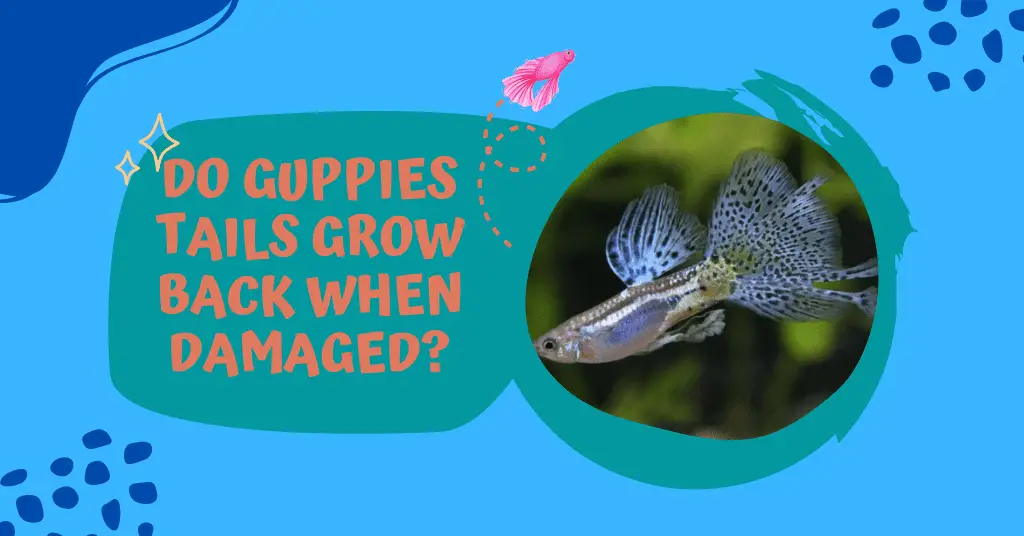Last Updated on September 27, 2021 by cmoarz
It’s inevitable for all guppy owners at some point or another. Eventually, your guppy’s tail will be damaged, either from a filter or from another aggressive fish or aquarium fish or even fin rot. The same can be said for fins and tails. All things heal with time- But do guppies tails grow back?
The answer is pretty simple!

Do guppies tails grow back?
Table of Contents
Yes! Your guppies fins and tails will eventually grow back as long as the damage isn’t too extensive. This usually takes a few weeks. Guppy tails heal, as do dorsal and anal fins when given enough time. But there are some things you need to address first before you go about waiting for your male guppies (or female guppy) tails to regrow.
You have to treat the damage first to avoid fin rot
Fin rot is a scary word, but at the end of the day, They are just simple bacterial infections that has invaded a fish tail, caudal fin etc. This can happen to guppy fish, betta fish, or most aquarium fish really. It’s generally due to poor water quality infecting a wound.
Also known as fish tail rot, or just tail rot, It’s scary to think about, Luckily it’s super easy to avoid, to begin with!
So, no matter if your fishes fins were just damaged by fin nipping or getting stuck in a filter impeller, The first thing you need to do is know how to treat it before it can begin to heal, Just like a human wound would be treated.
The first step is to clean the tank water. Pristine water will help your guppy tail avoid fin rot. Your aquarium water parameters should also be optimal. (Correct ammonia levels of 0 for example), as ammonia will exasperate the issue and cause burns to the damaged skin. Poor water quality will almost certainly ensure fin rot kicks in and that’s obviously the first thing you need to deal with.
So with that said, Do a nice big fat water change. Ez pz.
Guppies tail are notoriously fragile, and there’s a good chance even with clean tank water your damaged guppy tail could still end up with some sort of bacteria infection. Doesn’t matter which one either, At the end of the day they are all “fin rot”.
So let’s deal with that inevitability.

You have 2 very good options to treat fin rot, even as a preventative
Salt your tank
Adding aquarium salt to your freshwater aquarium is one of the best preventative methods as well as a high success chance to treat fin rot itself. Don’t worry, the dose of salt you use won’t hurt your fish! There are a few things you need to be aware of, however.
If you have snails or shrimp in your tank (like cherry shrimp) you can not salt your tank. Don’t worry about your other fish such as scaleless fish like corydoras though, They’re fine.
Assuming you don’t have any anthropods in your tank and, please do your due diligence for the rest of your community fish – This is how you salt your tank.
1 teaspoon of aquarium (or none iodized kosher salt) per 1 gallon of water. Be sure to take into account how much water your substrate, decorations, and plants displace.
Dissolve the salt in some aquarium water before adding it to the tank.
Now if you can’t add salt to your tank because of other fish or shrimp and snails, Consider setting up a small hospital tank. It’s really easy to do, so this article won’t go into the details on that.
You also have another option.
API Mealafix
API mealafix is a commercial fin rot treatment, and it’s basically just a bacteria removal medication. It works really well as a preventative measure before you have an outbreak, or as a cure after all else fails.
It’s composed of 1.0 percent Melaleuca (Tea Tree) oil, water, and an emulsifier to mix the oil in with the water.
Or in other words, a very good anti-bacterial. I definitely suggest using this as a preventative if you can.
There are some other fin rot treatments out there on the market, but they’re basically just more of the same. Salt or medicated food, or liquid. (Most) are safe to use both together as well! Just do your due diligence on whatever you choose to use as some medications DO NOT MIX WITH SALT.
Make sure they can get to the food
Depending on how bad the dorsal fin or other damaged fins are, your fish might have trouble getting around. This is especially true for big-finned fancy guppies.
Even if your fish is only slightly crippled in speed, Too many fish in the tank can cause an issue of not being able to reach the food.
This is especially true for female guppies. Female guppies are much timider than male guppies and may avoid confrontation with other fish. It’s always better to put your female fish into a hospital tank when possible and feed brine shrimp and regular food. Avoid feeding outdated food.

Now you wait
Now that you avoided the possibility of a bacterial infection and any other underlying disease associated with a bacterial infection, And no external organs are protruding from the wounds, your entire tank is clean, or you’ve placed them into a separate tank, the only thing left is to wait.
The hard part is done, and in a few weeks, you will notice your fish’s fins start to heal. Frayed fins will begin to repair themselves and your guppies’ ripped fins will begin to come together.
If the damage is too extensive, can your fish live without its fin if it’s not being repaired? Yes, it can. Plenty of fish do just fine. Guppies losing their fins aren’t the end of the world, in fact, guppies lose their fins all the time due to aggressive fish and still live long lives.
You should consider removing aggressive fish from the tank in the future if this continues to happen, Though.
Good luck!
About
Owner of AquariumGravel.com and also owner of actual Aquarium Gravel believe it or not! ;). Setting up beautiful aquarium sceneries and habitats since I was very young. Enjoy!
- Web |
- More Posts(290)

